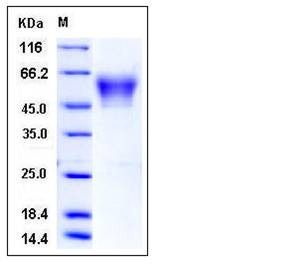Human Neurexin-3-beta / NRXN3 Protein (His Tag)
C14orf60
- 100ug (NPP4125) Please inquiry
| Catalog Number | P11843-H08H |
|---|---|
| Organism Species | Human |
| Host | Human Cells |
| Synonyms | C14orf60 |
| Molecular Weight | The recombinant human NRXN3 consists of 333 amino acids and predictes a molecular mass of 36 kDa. In SDS-PAGE under reducing conditions, the apparent molecular mass of rhNRXN3 is approximately 50-60 kDa due to glycosylation. |
| predicted N | Ser 36 |
| SDS-PAGE |  |
| Purity | > 94 % as determined by SDS-PAGE |
| Protein Construction | A DNA sequence encoding the human NRXN3 beta isoform 2 (NP_620426.2) extracellular domain (Met 1-Thr 357) was expressed, with a polyhistidine tag at the C-terminus. |
| Bio-activity | Measured by the ability of the immobilized protein to support the adhesion of C6 Rat brain glial cells . When 5 x 10E4 cells/well are added to NRXN3 coated plates (0.8 μg/ml and 100 μl/well), approximately 30%-50% will adhere specifically after 60 minutes at 37 ℃. |
| Research Area | Neuroscience |Cell Adhesion Proteins |Membrane Proteins |
| Formulation | Lyophilized from sterile PBS, pH 7.4 1. Normally 5 % - 8 % trehalose, mannitol and 0.01% Tween80 are added as protectants before lyophilization. Specific concentrations are included in the hardcopy of COA. |
| Background | Neurexin-3-beta, also known as Neurexin III-beta and NRXN3, is a single-pass type I membrane protein which belongs to the neurexin family. It contains one laminin G-like domain. It is a neuronal cell surface protein that may be involved in cell recognition and cell adhesion. Neurexins are a family of proteins that function in the vertebrate nervous system as cell adhesion molecules and receptors. They are encoded by several unlinked genes of which two, NRXN1 and NRXN3, are among the largest known human genes. Three of the genes ( NRXN1, NRXN2, NRXN3 ) utilize two alternate promoters and include numerous alternatively spliced exons to generate thousands of distinct mRNA transcripts and protein isoforms. The majority of transcripts are produced from the upstream promoter and encode alpha-neurexin isoforms; a much smaller number of transcripts are produced from the downstream promoter and encode beta-neurexin isoforms. The alpha-neurexins contain EGF-like sequences and laminin G domains, and have been shown to interact with neurexophilins. The beta-neurexins lack EGF-like sequences and contain fewer laminin G domains than alpha-neurexins. NRXN3 have been linked to genetic predisposition towards a number of conditions such as alcohol or drug addiction, or obesity. |
| Reference |
